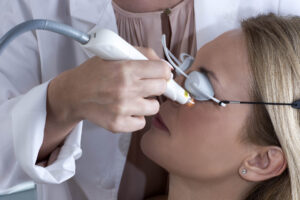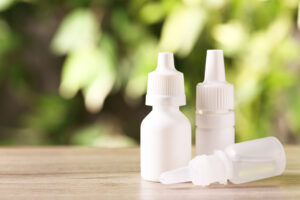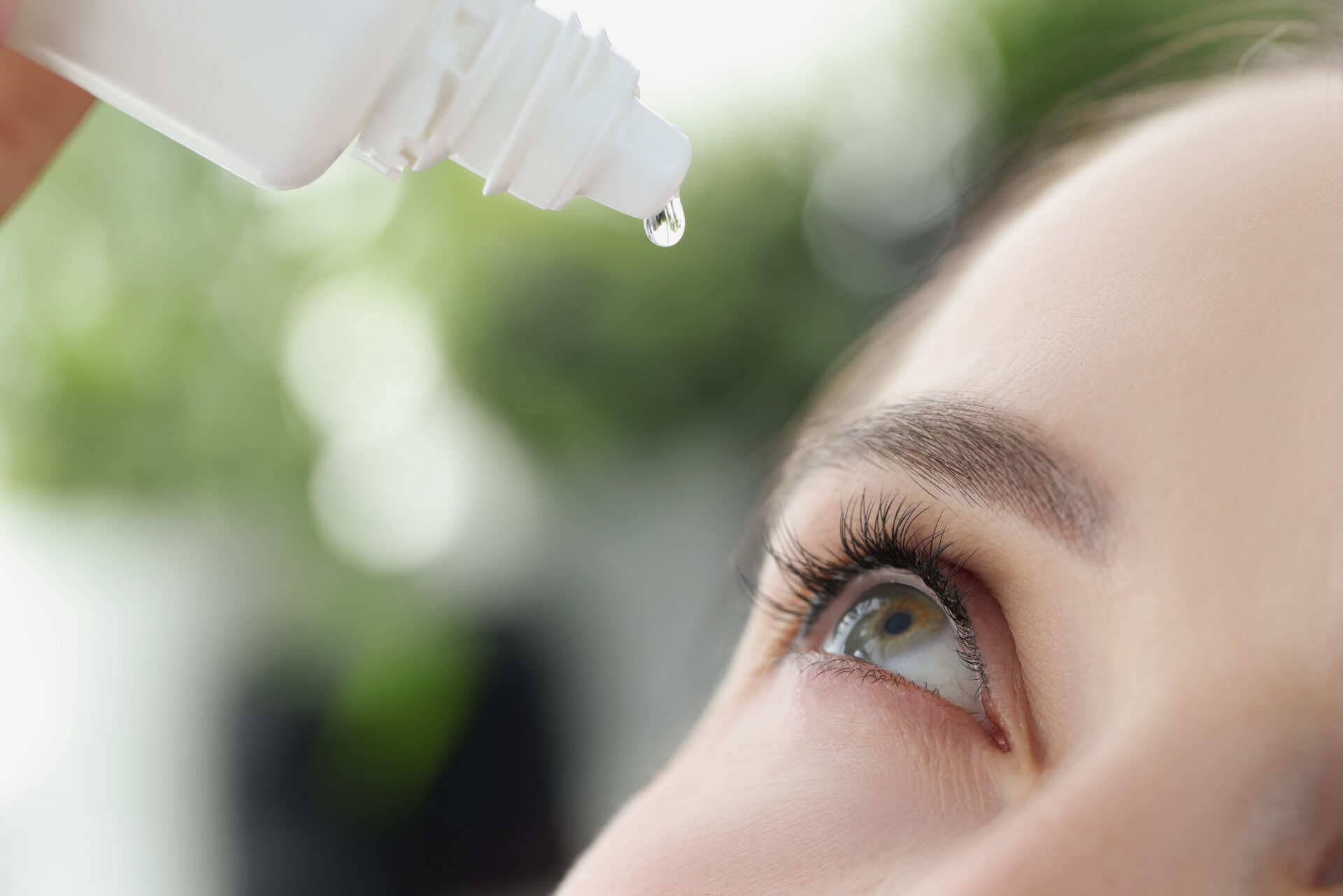Eye Lubricants

Non-preserved artificial tears are important for individuals with dry eye for several reasons:
Reduced Risk of Irritation:
Preservatives used in some artificial tears, such as benzalkonium chloride (BAK), can cause irritation and sensitivity in the eyes, particularly with long-term use. Non-preserved artificial tears eliminate the risk of adverse reactions associated with preservatives, making them suitable for individuals with sensitive eyes or those who experience discomfort from preservative-containing drops.
Minimized Risk of Allergic Reactions:
Some individuals may be allergic or hypersensitive to preservatives commonly used in artificial tears. Non-preserved formulations eliminate the risk of allergic reactions, providing a safer option for those prone to allergies or with known sensitivities to preservatives.
Longer Shelf Life:
Preservatives are added to artificial tears to prevent microbial contamination and extend their shelf life once the bottle is opened. However, preservatives can also contribute to the degradation of certain ingredients over time. Non-preserved artificial tears typically have a shorter shelf life after opening compared to preserved formulations. However, for individuals who use artificial tears frequently, the shorter shelf life may not be a significant concern.
Better Compatibility with Contact Lenses:
Preservatives in artificial tears can accumulate on contact lenses and contribute to discomfort or intolerance, especially with prolonged use. Non-preserved artificial tears are often recommended for individuals who wear contact lenses to minimize the risk of lens-related irritation and maintain optimal comfort throughout the day.
Suitability for Sensitive Eyes:
Some individuals may have conditions or sensitivities that make their eyes more prone to irritation or inflammation. Non-preserved artificial tears provide a gentle and soothing option for these individuals, helping to alleviate dryness and discomfort without exacerbating underlying eye conditions.
Overall, non-preserved artificial tears offer a safe and effective option for individuals with dry eye, providing lubrication and relief from symptoms without the potential drawbacks associated with preservatives. It is essential to consult with an eye care professional to determine the most suitable artificial tear formulation based on individual needs and preferences.
Omega 3s

Triglyceride-based omega-3 supplements are often preferred over ethyl ester omega-3 supplements for the treatment of dry eye syndrome due to several factors:
Bioavailability:
Triglyceride-based omega-3 supplements are structurally similar to the omega-3 fatty acids found naturally in fish and are more readily absorbed by the body compared to ethyl ester forms. This increased bioavailability ensures that a higher proportion of the omega-3 fatty acids reach the target tissues, including the ocular surface, where they can exert their beneficial effects.
Stability:
Triglyceride-based omega-3 supplements are more stable than ethyl ester forms, reducing the risk of oxidation and rancidity. Oxidized omega-3 fatty acids can have pro-inflammatory effects and may counteract the anti-inflammatory benefits sought in the treatment of dry eye syndrome.
Efficacy:
Clinical studies have demonstrated that triglyceride-based omega-3 supplements are more effective than ethyl ester forms in alleviating symptoms of dry eye syndrome and improving tear film quality. The superior absorption and stability of triglyceride-based omega-3s contribute to their efficacy in reducing ocular surface inflammation and promoting tear production.
Overall, non-preserved artificial tears offer a safe and effective option for individuals with dry eye, providing lubrication and relief from symptoms without the potential drawbacks associated with preservatives. It is essential to consult with an eye care professional to determine the most suitable artificial tear formulation based on individual needs and preferences.
Overall, triglyceride-based omega-3 supplements offer a more reliable and effective option for individuals seeking relief from dry eye symptoms, providing essential fatty acids in a form that maximizes absorption and therapeutic benefits.
Thermal Treatments - Warm Compresses

Warm compresses play a crucial role in the treatment of dry eye syndrome for several reasons:
Promotes Meibomian Gland Function:
Warm compresses help to liquefy the thickened meibum (oil) produced by the meibomian glands located along the eyelid margins. By applying heat to the eyelids, the meibum becomes more fluid, making it easier for the glands to secrete oil onto the surface of the eye. This process helps to improve the quality of the tear film and reduce tear evaporation, addressing one of the underlying causes of dry eye.
Enhances Tear Film Stability:
The oil produced by the meibomian glands plays a crucial role in maintaining the stability of the tear film. By applying warmth to the eyelids, the lipid layer of the tear film becomes more uniform and spreads more evenly across the ocular surface. This helps to prevent rapid tear evaporation and maintain adequate moisture on the eyes, reducing symptoms of dryness, irritation, and discomfort.
Improves Eye Comfort:
Warm compress therapy provides soothing relief to the eyes, helping to alleviate symptoms such as eye fatigue, irritation, and discomfort associated with dry eye syndrome. The warmth helps to relax the muscles around the eyes and promote a sense of relaxation and comfort, making it an effective adjunctive therapy for managing dry eye symptoms.
Overall, warm compress therapy is an essential component of dry eye treatment, helping to improve meibomian gland function, enhance tear film stability, alleviate eyelid inflammation, and promote overall eye comfort. It can also be an important component of ensuring longevity of other dry eye treatments such as intense pulsed light.
Lid Hygiene

Lid hygiene is essential for dry eye treatment due to its role in maintaining the health of the eyelids and promoting a stable tear film. Here are several reasons why lid hygiene is important:
Removal of Debris and Bacteria:
Proper lid hygiene involves gently cleansing the eyelids and eyelashes to remove debris, oil, and bacteria that can accumulate along the eyelid margins. This helps to prevent blockages in the meibomian glands, which produce the oil component of the tear film. Blockages can lead to meibomian gland dysfunction (MGD), a common cause of evaporative dry eye.
Prevention of Blepharitis:
Blepharitis is a condition characterized by inflammation of the eyelids, often caused by bacteria or overgrowth of the skin's natural flora. Poor lid hygiene can contribute to the development of blepharitis, leading to symptoms such as redness, swelling, itching, and irritation. By practicing regular lid hygiene, individuals can help prevent blepharitis and reduce the risk of associated dry eye symptoms.
Promotion of Meibomian Gland Function:
Meibomian glands play a crucial role in producing the oil layer of the tear film, which helps to prevent tear evaporation and maintain ocular surface lubrication. Proper lid hygiene, including warm compresses and gentle massage techniques, can help to unclog blocked meibomian glands, improve oil secretion, and enhance tear film stability.
Control of Demodex Infestation:
Demodex infestation is crucial for individuals with dry eye, particularly those with blepharitis or other inflammatory conditions of the eyelids. Demodex mites are microscopic organisms that inhabit the hair follicles and sebaceous glands of the eyelids and can contribute to inflammation and irritation, exacerbating dry eye symptoms. Proper lid hygiene, including regular cleansing with lid scrubs or foam cleansers containing tea tree oil, can help to reduce Demodex populations and alleviate associated symptoms. Additionally, targeted treatments such as tea tree oil-based solutions or medicated wipes may be recommended by eye care professionals to effectively manage Demodex infestation and improve ocular surface health. By addressing Demodex colonization as part of a comprehensive dry eye management plan, individuals can experience enhanced relief from symptoms and improved overall eye comfort.
Reduction of Inflammation:
Inflammation of the eyelids, whether due to blepharitis or other causes, can exacerbate dry eye symptoms and lead to further complications. By practicing good lid hygiene, individuals can help reduce inflammation along the eyelid margins, promoting overall eye health and comfort.
Enhancement of Treatment Efficacy:
Lid hygiene is often recommended as part of a comprehensive dry eye treatment plan, alongside other therapies such as artificial tears, warm compress therapy, and prescription medications. By maintaining clean and healthy eyelids, individuals can optimize the effectiveness of these treatments and improve their overall dry eye management.
Overall, incorporating regular lid hygiene practices into a daily routine is essential for managing dry eye symptoms, promoting ocular surface health, and enhancing overall eye comfort and function. It is important to consult with an eye care professional to determine the most appropriate lid hygiene regimen based on individual needs and symptoms.
Intense Pulsed Light

Meibomian glands, located within the eyelids, are responsible for producing the oily component of tears, known as meibum. This oil forms the outermost layer of the tear film, which plays a crucial role in preventing tear evaporation and maintaining tear film stability. The lipid layer helps to lubricate the ocular surface, reduce friction during blinking, and protect against environmental factors such as wind, dust, and dry air. Dysfunction of the meibomian glands, often associated with conditions like meibomian gland dysfunction (MGD) or ocular rosacea, can lead to poor tear film quality, increased tear evaporation, and evaporative dry eye. By addressing meibomian gland dysfunction and restoring the lipid layer of tears, treatments like IPL therapy can effectively alleviate dry eye symptoms and improve ocular surface health.
Intense Pulsed Light (IPL) therapy has emerged as a valuable treatment modality for dry eye syndrome, particularly in cases associated with ocular rosacea. Here's why IPL is important for dry eye treatment, including ocular rosacea:
Targets Inflammation:
IPL therapy targets inflammation in the eyelids and surrounding areas, making it particularly effective for conditions such as ocular rosacea, which is characterized by chronic inflammation of the skin and blood vessels. By reducing inflammation, IPL helps to alleviate symptoms associated with ocular rosacea, such as redness, burning, stinging, and dryness.
Improves Meibomian Gland Function:
IPL therapy can improve the function of the meibomian glands, which play a crucial role in producing the oil component of the tear film. In conditions like ocular rosacea and meibomian gland dysfunction (MGD), the meibomian glands may become blocked or dysfunctional, leading to poor tear film quality and evaporative dry eye. IPL therapy helps to unclog blocked glands, promote oil secretion, and restore tear film stability.
Reduces Vascular Abnormalities:
IPL targets abnormal blood vessels and vascular structures in the eyelids, which are often present in conditions like ocular rosacea. By selectively heating and coagulating these vessels, IPL helps to improve blood flow and reduce vascular leakage, leading to a decrease in inflammation and an improvement in dry eye symptoms.
Stimulates Collagen Production:
IPL therapy stimulates collagen production in the skin and connective tissues, leading to improvements in skin texture and elasticity. In addition to targeting inflammation and vascular abnormalities, IPL can help strengthen the structural integrity of the eyelids and surrounding tissues, contributing to overall eye health and comfort.
Long-lasting Relief:
IPL therapy offers long-lasting relief from dry eye symptoms, with many patients experiencing significant improvement after just a few treatment sessions. By addressing the underlying causes of dry eye, including inflammation, vascular abnormalities, and meibomian gland dysfunction, IPL therapy can provide lasting benefits and improve overall quality of life for individuals with ocular rosacea and associated dry eye. Compliance with at home treatments are critical at prolonging the effectiveness of IPL treatments for dry eye
Overall, IPL therapy is an important treatment option for individuals with dry eye syndrome, especially those with ocular rosacea. By targeting inflammation, improving meibomian gland function, and reducing vascular abnormalities, IPL therapy offers effective relief from dry eye symptoms and helps to restore ocular surface health and comfort.
Lid Debridement
Lid debridement, often performed using techniques such as ZEST (Ziemer Eyelid Surface Treatment), plays a crucial role in dry eye treatment by addressing underlying eyelid conditions and promoting ocular surface health. Here's why lid debridement is important:
Clears Debris and Biofilm:
Lid debridement removes accumulated debris, biofilm, and other substances from the eyelid margins and lash follicles. These materials can harbor bacteria, allergens, and inflammatory mediators, contributing to eyelid inflammation, meibomian gland dysfunction (MGD), and dry eye symptoms. By clearing away these obstructions, lid debridement helps to improve eyelid hygiene and reduce the risk of further inflammation.
Promotes Meibomian Gland Function:
Meibomian glands, located within the eyelids, produce the oil component of tears that helps to prevent tear evaporation and maintain tear film stability. Blockages or dysfunction of these glands, often seen in conditions like MGD, can lead to poor tear film quality and evaporative dry eye. Lid debridement helps to unclog blocked meibomian glands, allowing for better secretion of oil onto the ocular surface and improving tear film composition.
Reduces Inflammation:
Inflammatory conditions of the eyelids, such as blepharitis or ocular rosacea, can exacerbate dry eye symptoms by causing irritation, redness, and swelling. Lid debridement helps to reduce inflammation by removing inflammatory mediators, bacteria, and other irritants from the eyelid margins. By reducing inflammation, lid debridement can alleviate dry eye symptoms and promote overall ocular surface health.
Enhances Treatment Efficacy:
Lid debridement is often used in conjunction with other dry eye treatments, such as warm compress therapy, artificial tears, and prescription medications. By improving eyelid hygiene and meibomian gland function, lid debridement can enhance the effectiveness of these treatments and improve overall dry eye management.
Improves Comfort and Quality of Life:
Dry eye syndrome can significantly impact quality of life, causing discomfort, blurred vision, and difficulty performing daily activities. By addressing underlying eyelid conditions and promoting ocular surface health, lid debridement can help alleviate dry eye symptoms, improve eye comfort, and enhance overall quality of life for individuals with dry eye.
Overall, lid debridement is an important component of dry eye treatment, helping to improve eyelid hygiene, promote meibomian gland function, reduce inflammation, and enhance the effectiveness of other dry eye therapies. By incorporating lid debridement into a comprehensive dry eye management plan, individuals can experience improved ocular surface health and greater comfort.
Plasma Rich Growth Factor
Plasma rich growth factor (Endoret) therapy has emerged as a valuable treatment option for dry eye syndrome, offering several benefits that contribute to improved ocular surface health and symptom relief. Here's why Endoret therapy is important for dry eye treatment:
Promotes Tissue Regeneration:
Endoret therapy harnesses the regenerative properties of growth factors found in the patient's own blood plasma to promote tissue repair and regeneration on the ocular surface. By stimulating cellular proliferation and differentiation, Endoret therapy helps to repair damaged epithelial cells, enhance tear film stability, and restore corneal and conjunctival health.
Reduces Inflammation:
Inflammatory processes play a significant role in the development and progression of dry eye syndrome. Endoret therapy delivers anti-inflammatory cytokines and growth factors to the ocular surface, helping to suppress inflammation, modulate immune responses, and alleviate dry eye symptoms associated with ocular surface inflammation.
Enhances Tear Film Quality:
Endoret therapy promotes the production of healthy tears by improving meibomian gland function and increasing tear film stability. By stimulating the secretion of lipid-rich tears, Endoret therapy helps to prevent tear evaporation and maintain optimal hydration of the ocular surface, reducing symptoms of dryness, irritation, and discomfort.
Minimally Invasive and Well-Tolerated:
Endoret therapy is a minimally invasive procedure that involves collecting a small sample of the patient's blood, processing it to isolate growth factors and platelet-rich plasma, and then applying the concentrated growth factors to the ocular surface. The procedure is well-tolerated by most patients and does not require significant downtime, making it a convenient and accessible option for dry eye treatment.
Long-lasting Relief:
Endoret therapy offers long-lasting relief from dry eye symptoms, with many patients experiencing sustained improvements in ocular surface health and comfort after a series of treatments. By addressing the underlying causes of dry eye, including inflammation and tissue damage, Endoret therapy can provide lasting benefits and improve overall quality of life for individuals with dry eye syndrome.
What to expect during your procedure:
During Endoret therapy for dry eye treatment, patients can expect the following:
Consultation and Evaluation:
The procedure typically begins with a comprehensive consultation and evaluation by an eye care professional to assess the patient's dry eye symptoms, medical history, and suitability for Endoret therapy. The doctor will discuss the procedure, potential benefits, and any associated risks or side effects with the patient.
Blood Collection:
If deemed appropriate for Endoret therapy, the patient will schedule an appointment at a qualified lab to undergo a simple blood, similar to a routine blood test. A small sample of the patient's blood is collected using a sterile technique.
Centrifugation:
The collected blood sample is then processed using a specialized centrifuge device to separate the components of the blood, including platelet-rich plasma (PRP) and growth factors. This process typically takes a short amount of time, usually within the same appointment.
Preparation of Endoret:
Once the centrifugation process is complete, the isolated PRP and growth factors, known as Endoret, are prepared for application to the ocular surface. The Endoret solution is carefully extracted and prepared for administration.
Application to the Ocular Surface:
The Endoret solution is applied to the ocular surface using a sterile applicator or dropper under the supervision of an eye care professional. The procedure is typically performed in-office and may involve the use of anesthetic eye drops to ensure patient comfort.
Post-procedure Instructions:
After Endoret therapy, patients may receive specific instructions from their doctor regarding post-procedure care and follow-up appointments. It is essential to adhere to these instructions carefully to optimize the effectiveness of the treatment and minimize the risk of complications.
Monitoring and Follow-up:
Patients may be scheduled for follow-up appointments to monitor their progress and evaluate the response to Endoret therapy. Additional treatments may be recommended based on individual response and treatment goals.
Overall, Endoret therapy represents a promising approach to dry eye treatment, offering a safe, effective, and minimally invasive option for promoting ocular surface health, reducing inflammation, and alleviating dry eye symptoms. As part of a comprehensive dry eye management plan, Endoret therapy can help individuals achieve improved tear film quality, enhanced comfort, and better overall eye health.
Amniotic Membranes
Amniotic membranes are a valuable treatment option for severe dry eye disease, offering several benefits that contribute to improved ocular surface health and symptom relief. Here's why amniotic membranes are important for dry eye treatment:
Promotes Healing and Regeneration:
Amniotic membranes contain a rich array of growth factors, cytokines, and extracellular matrix proteins that promote tissue repair, regeneration, and wound healing. When applied to the ocular surface, amniotic membranes provide a scaffold for cellular proliferation and differentiation, helping to restore damaged epithelial cells, reduce inflammation, and improve tear film stability.
Reduces Inflammation:
Inflammatory processes play a significant role in the development and progression of dry eye disease. Amniotic membranes possess anti-inflammatory properties and release factors that help to modulate immune responses, suppress inflammation, and alleviate dry eye symptoms associated with ocular surface inflammation.
Protects and Lubricates the Ocular Surface:
Amniotic membranes act as a natural barrier to protect the ocular surface from mechanical trauma, environmental insults, and microbial invasion. The presence of lubricating factors within the amniotic membrane helps to hydrate and lubricate the ocular surface, reducing friction during blinking and improving overall eye comfort.
Enhances Epithelialization:
Amniotic membranes facilitate the migration and proliferation of epithelial cells, promoting the re-epithelialization of the ocular surface. This helps to repair epithelial defects, improve corneal clarity, and restore visual function in patients with severe dry eye disease or corneal epithelial damage.
Provides Pain Relief:
Severe dry eye disease can cause significant discomfort, including burning, stinging, and foreign body sensation. Amniotic membrane transplantation can provide rapid relief from pain and discomfort by promoting healing, reducing inflammation, and restoring ocular surface integrity.
What to Expect Before, During, and After the Procedure:
Before the Procedure:
Prior to amniotic membrane transplantation, patients will undergo a comprehensive evaluation to assess the severity of their dry eye disease and determine their suitability for the procedure. The doctor will discuss the procedure, potential benefits, and any associated risks or side effects with the patient.
During the Procedure:
Amniotic membrane transplantation is typically performed in-office. The procedure involves the placement of a dehydrated amniotic membrane patch onto the ocular surface. The doctor will carefully position the membrane over the affected area of the eye and secure it in place with a bandage contact lens.
After the Procedure:
Following amniotic membrane placement, patients may experience mild discomfort, tearing, or foreign body sensation, which typically resolves within a few days. Patients may be instructed to discontinue lubricating eye drops for a period of time following the procedure. You can expect your vision to be blurry for 1-3 weeks after the procedure while the membrane is absorbed. Follow-up appointments may be scheduled to monitor healing progress and assess treatment outcomes.
Overall, amniotic membranes offers a safe, effective, and minimally invasive option for treating severe dry eye disease and promoting ocular surface health. By harnessing the regenerative properties of amniotic membranes, this innovative therapy can provide significant relief from dry eye symptoms and improve overall quality of life for patients with advanced dry eye disease.
Topical Pharmaceuticals

Multiple topical pharmaceutical drops are available to be prescribed for the treatment of dry eye disease due to their unique mechanisms of action and effectiveness in alleviating dry eye symptoms. Here's why these medications are useful:
Restasis (Cyclosporine A):
Immunomodulatory Properties:
Restasis contains cyclosporine A, which acts as an immunomodulator to suppress inflammation on the ocular surface. Inflammation plays a significant role in the development and progression of dry eye disease, and by reducing inflammation, Restasis helps to improve tear film stability and reduce dry eye symptoms.
Promotes Tear Production:
Restasis stimulates the lacrimal glands to produce more tears, increasing tear volume and improving ocular surface lubrication. By enhancing tear production, Restasis helps to alleviate symptoms of dryness, burning, and discomfort associated with dry eye disease.
Cequa (Cyclosporine A):
Nanoemulsion Formulation:
Cequa is a newer formulation of cyclosporine A that utilizes a nanoemulsion technology to enhance drug penetration and distribution on the ocular surface. This allows for better absorption of cyclosporine A into the target tissues, leading to improved efficacy in reducing inflammation and promoting tear production.
Longer Duration of Action:
Cequa offers the convenience of less frequent dosing compared to traditional cyclosporine formulations, with once-daily administration providing sustained relief from dry eye symptoms throughout the day. This longer duration of action helps to maintain consistent tear film stability and ocular surface lubrication.
Xiidra (Lifitegrast):
Inhibits Inflammatory Pathways:
Xiidra contains lifitegrast, a small molecule integrin antagonist that targets inflammatory pathways involved in dry eye disease. Lifitegrast inhibits the binding of inflammatory molecules to ocular surface cells, thereby reducing inflammation and alleviating dry eye symptoms.
Improves Tear Film Stability:
Xiidra helps to stabilize the tear film by promoting mucin production and reducing tear film instability. By enhancing tear film quality, Xiidra helps to minimize tear evaporation and maintain optimal hydration of the ocular surface, resulting in improved comfort and visual clarity.
Overall, Restasis, Cequa, and Xiidra are valuable treatment options for dry eye disease due to their ability to reduce inflammation, promote tear production, and improve tear film stability. These medications offer effective relief from dry eye symptoms and can help improve overall ocular surface health and comfort for patients with dry eye disease.
Punctal Plugs
Punctal plugs, are small inserts placed in the tear ducts to block the drainage of tears from the ocular surface. They are useful in the treatment of dry eye for several reasons:
Conserves Tears:
Punctal plugs help to conserve natural tears by reducing their drainage from the eyes. By blocking the tear drainage pathway, punctal plugs increase the amount of time tears remain on the ocular surface, providing prolonged lubrication and hydration to the eyes.
Improves Tear Film Stability:
Dry eye is often characterized by instability in the tear film, which can lead to symptoms such as discomfort, burning, and blurred vision. Punctal plugs help to stabilize the tear film by maintaining a more consistent tear volume on the ocular surface. This can improve visual clarity and reduce the frequency and severity of dry eye symptoms.
Enhances Efficacy of Other Treatments:
Punctal plugs can complement other dry eye treatments, such as artificial tears, prescription medications, and in-office procedures. By reducing tear drainage, punctal plugs enhance the efficacy of these treatments by ensuring that the tears remain on the ocular surface for a longer duration, maximizing their therapeutic effects.
Customizable and Reversible:
Punctal plugs come in various sizes and materials to accommodate individual patient needs and preferences. They can be easily inserted and removed by an eye care professional during an office visit, making them a customizable and reversible treatment option for dry eye. This allows for adjustments in treatment as needed and minimizes the risk of complications.
Minimal Discomfort:
Punctal plugs are generally well-tolerated by patients and cause minimal discomfort. Most patients do not experience any sensation or awareness of the plugs once they are inserted. However, if discomfort or irritation occurs, the plugs can be easily removed or replaced by an eye care professional.
Overall, punctal plugs are a valuable treatment option for individuals with dry eye, offering a simple and effective way to increase tear retention, improve tear film stability, and alleviate dry eye symptoms. They provide a customizable and reversible solution for managing dry eye and can significantly enhance the quality of life for patients experiencing chronic dry eye symptoms
Maskin Probing
Maskin probing, also known as meibomian gland probing, is a procedure used to treat meibomian gland dysfunction (MGD), a common cause of evaporative dry eye. It involves the insertion of specialized probes into the meibomian gland orifices to clear blockages and restore normal gland function. Maskin probing is useful in the treatment of dry eye for several reasons:
Clears Meibomian Gland Blockages:
In MGD, the meibomian glands become blocked or obstructed, leading to a decrease in the secretion of meibum, the oily component of tears. This can result in tear film instability and evaporative dry eye. Maskin probing helps to clear blockages within the meibomian glands, allowing for the proper flow of meibum and improving tear film quality.
Restores Meibomian Gland Function:
By clearing blockages and opening the meibomian gland orifices, maskin probing helps to restore normal gland function. This allows for the secretion of healthy, lipid-rich meibum onto the ocular surface, which helps to prevent tear evaporation and maintain tear film stability. Restoring meibomian gland function is essential for alleviating dry eye symptoms and improving ocular surface health.
Promotes Tear Film Stability:
Meibum plays a crucial role in stabilizing the tear film and reducing tear evaporation. By restoring meibomian gland function, maskin probing helps to improve tear film stability and reduce the risk of dry eye symptoms such as irritation, burning, and blurred vision. This can lead to improved comfort and visual clarity for patients with evaporative dry eye.
Long-lasting Relief:
Maskin probing can provide long-lasting relief from dry eye symptoms, with many patients experiencing sustained improvement in tear film quality and ocular surface health following the procedure. By addressing the underlying cause of MGD, maskin probing offers a comprehensive solution for managing evaporative dry eye and improving overall eye comfort and function.
Minimally Invasive:
Maskin probing is a minimally invasive procedure that is typically performed in-office by an eye care professional. The procedure is well-tolerated by most patients and involves minimal discomfort. Recovery time is usually brief, and patients can resume normal activities shortly after the procedure.
Overall, maskin probing is a valuable treatment option for individuals with evaporative dry eye due to meibomian gland dysfunction. By clearing blockages, restoring gland function, and promoting tear film stability, maskin probing offers effective relief from dry eye symptoms and helps to improve overall ocular surface health and comfort.
